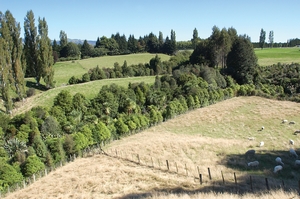Exotic forestry has positive ecosystem service value

In 2014, Scion’s Economics, Ecosystems and Climate Team was contracted by the Bay of Plenty Regional Council to evaluate the ecosystem services relevant to different land uses in the Ōhiwa catchment.
Identifying, and attributing a value to, the key ecosystem services provided by each land use will provide the council with a framework for land management that will see the potential of each service realised.
“We define ecosystem services as the flow of benefits people gain from ecosystems, such as food, fibre, carbon sequestration, recreation and avoided erosion,” says resource economist Dr Richard Yao.
“Food and fibre have traditionally been considered more important than the other groups because of their monetary value. Services such as recreational walking and avoided sedimentation in waterways, are already recognised in policy but have non-monetary values, which make them less clearly understood.
“The development of non-monetary valuation techniques now makes it possible to estimate the value of these services and include them in land management discussions, alongside those services with monetary values. This allows better policy to be made.”
The team identified seven major land uses in the catchment, both productive (dry stock, exotic forests, dairy and horticulture) and natural (indigenous forest, scrub, and wetlands and mangroves). Researchers also applied Scion’s Forest Investment Finder economic model to analyse the value of key ecosystem services such as timber, carbon and avoided sedimentation.
Of the productive land uses, horticulture and dairy were found to provide the highest monetary values (i.e. profit), with exotic forestry and dry stock the lowest. The monetary value of horticulture was over five times higher than dairy, and 18 times higher than exotic forestry.
However, when services with non-monetary values were included, exotic forestry was found to be the only productive land use with a positive ecosystem service value. Among natural land uses, wetlands provided the highest value per hectare, followed by indigenous forest and scrub.
The research team used several scenarios to demonstrate the potential profitability of various productive land uses, and the environmental and social values from both productive and conservation land. This exercise illustrated ways in which the overall economic, environmental and social values of the catchment could be improved.
“Our results suggest that shifting to a more sustainable productive land use can raise the overall ecosystem services value in the catchment,” says Richard. “For example, converting 320 hectares of dry stock to exotic forestry could provide a net gain of $8,906 per hectare per year, and increase the ecosystem services value in the catchment by $2.8 million. Adopting a more environmentally friendly technology or farm practice that reduces nutrient leaching in the waterways could double the overall ecosystem services value in the catchment.
“The monetary values we are reporting here are indicative, not absolute dollar values, but provide a good starting point from which council can begin comprehensive land management planning for the Ōhiwa catchment that will deliver beneficial ecosystem services, particularly around water management. Good planning will sustain and enhance the provision of those services for economic prosperity and improved human well-being.”
The final report was completed in October 2014 and will contribute to the Bay of Plenty Regional Council’s planning and policy discussions in land use management. These data have also benefited other Scion-wide projects such as the Growing Confidence in Forestry’s Future and other related projects.
